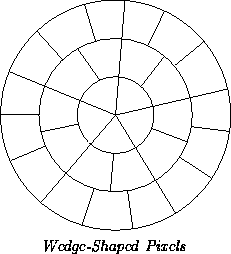As a graph is a visual object, we now preoccupy ourselves with rendering graphs. We will not attempt to fully render any graph; the influence we may exert on the world does not permit us to render either the intricate details or the vast stretches present in most graphs. We will content ourselves, for now, with discretely rendering small portions of graphs.
There is a wide variety of physical rendering devices which may be controlled by modern computers. Examples include: monitors, projection units, laser printers, ink-jet printers, dot-matrix printers, thermal printers, and plotters. We phrase our discussion in terms of an abstract rendering device, which approximates actual rendering devices. Our abstract rendering device outputs a perfectly rendered image R, which is a collection of pixels.
Usually, the pixels are rectangular in shape and form a ![]() grid.
Each pixel
grid.
Each pixel ![]() represents a region of the plane.
The pixel
represents a region of the plane.
The pixel ![]() represents the region
represents the region ![]() .
If M is given by
.
If M is given by
![]()
There are many other possibilities. When rendering with polar coordinates, it may be convenient to have pixels which are wedge-shaped and form concentric rings about the origin.

Another possibility is for each pixel to be in the shape of a small cube. As with rectangular pixels, a simple axis-aligned affine mapping may be used, but would now allow portions of space to be presented. Three-dimensional rendering devices would allow the rendering to be presented directly; two-dimensional rendering devices may present projections and slices of the rendering.
In the remainder of this chapter, our illustrations will be
of two-dimensional renderings using a grid of rectangular pixels.
The accompanying descriptions are general, and may be applied
to the other cases mentioned above. In higher (and lower) dimensions,
references to ![]() and
and ![]() may be replaced with references
to
may be replaced with references
to ![]() and
and ![]() , respectively.
, respectively.
| Jeff Tupper | March 1996 |